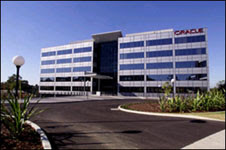I was thinking about 10 as I was putting this post together as it is the tenth in our series of ten on the death of SOA. I thought about Dudley Moore and Bo Derek in Blake Edwards '10'. I thought about Nigel Tufnel taking 10 all the way to 11 in 'This is Spinal Tap' - please take 51 seconds out of your busy day and watch this clip, you'll thank me for it. I finally settled on Ray and Charles Eames short documentary from 1977, 'Powers of Ten'. I liked how the powers of 10 idea fits with my thinking on architecture, the macro versus micro concerns that you are faced with, the importance of perspective, and the big picture.
Number 10 in this series brings us to letting the vendors drive the architecture. And I just love this one. Firstly I love the mental image of Larry Ellison, Sam Palmisano, Henning Kagermann and Vivek Ranadivé in a car together trying to decide where to go - that's once you've managed to get them in the same car in the first place.
And I love the absolute simplicity of this one. Hands up, who thinks that letting the vendors drive the architecture is a good idea? OK, so I know that hands-up as a device in a blog works about as well as it does on a podcast but that's not the point. If you do have your hand in the air then I need to take you on a brief English lesson. With thanks to the Macquarie Dictionary - "Vendor, noun, someone who vends or disposes of a thing by sale". Anglo-French, from vendre to sell, from Latin vendere. Newsflash, your vendor is trying to sell you something. Or even worse, your vendor is trying to dispose of something by sale - sounds bad doesn't it?
Disclosure, I work for a vendor, and yes I want to sell you something. There, I've said it. But I am not interested in selling you something once and disappearing. I know that the only way I can be successful is to build a long term relationship with my customers. I want to be able to keep doing business with my customers over the long term. Not just this quarter, or this year, but next year and the years to come. A mutually beneficial relationship where my customers are successful with the software and services that I can offer and I'm successful in seeing their projects delivered to production. That one-off sale is so last century, so 1.0, so shonky used-car-dealer that it's not even funny anymore. Maybe those sales people still exist - maybe those buyers still exist - but I don't recognise them from my experience. I have never met a customer that would be happy to let their vendor drive the architecture, and I have never met a vendor that would be able to.
Now, I get all a bit infinite monkey theorem here. You know the theory that states that a monkey hitting keys at random on a typewriter keyboard for an infinite amount of time will almost surely type a given text, such as the complete works of William Shakespeare. Let me explain, you can achieve your outcome with anyone driving that car - Larry, Sam, Henning, Vivek, it doesn't really matter. Given enough time - like the monkeys - each of their offerings will get you where you want to go. But you don't have enough time. And unlike the monkeys you certainly don't have infinite time. Yes, if you had unlimited time you can let the vendor drive the architecture and you'll get there. But given limited time and limited budget you need to find the vendor that you can share the driving with. When it's dark and raining. When you're tired. When you need someone to help you park or read the map. You need someone around that you can trust and rely on.
SOA isn't dead. It's not collateral damage roadkill as the vendors roar down the road in their architecure trucks. It's alive and well. If we return to Ann Thomas Manes of the Burton Group who started all this back in January, she wrote, "Although the word 'SOA' is dead, the requirement for service-oriented architecture is stronger than ever."
I think that's exactly what I've been trying to say all along.
-sean
The Oracle Australia and New Zealand Middleware and Technology Blog.
Subscribe to:
Post Comments (Atom)


No comments:
Post a Comment